Keyboard editor
Overview: keyboard and mouse in the emulation window
Pressing a key in the emulation window can trigger different program behaviors:
- A character is checked and transferred to an input field.
- A corresponding code is transferred to the host system.
- A programmed function, such as "start keyboard editor", is executed.
Using the mouse in the emulation window can trigger similar program behaviors:
- An area on the screen is selected.
- The cursor is set to the mouse position.
- A programmed function, such as "show context menu", is executed.
The keyboard and mouse settings can be customized as required:
- System administrators usually perform these customizations when configuring the system: from the default settings files, administrators select the appropriate settings for their implementation and make them available for their users as keyboard files.
- From this list, users simply select the keyboard file that is appropriate for their needs.
However, if required, you can also individually customize these settings
by using the keyboard editor.
Overview: keyboard editor
Using the keyboard editor, you can individually customize the keyboard and mouse settings for the emulation window and then save your changes as a keyboard file on the server.
The procedure for customizing the keyboard and mouse are mostly identical. You therefore make settings in a combined editor program ("keyboard editor"), and then save them in a single file ("keyboard file").
Special programming knowledge is not required.
Further details on how to proceed are described below:
If required, you can also perform special tasks such as:
- Listing temporary settings of keyboard and mouse.
- Loading or deleting another keyboard file.
- Editing the generated JavaScript source code of the current keyboard file.
Note:
- The keyboard and mouse settings of the LogWeb/Ajax terminal emulation are written in JavaScript (as are all components).
To customize settings, you can modify the JavaScript source code of each keyboard file, which, however, requires the corresponding programming knowledge.
- The keyboard editor significantly simplifies the customization process for you:
- It automatically generates the required JavaScript source code for you.
- You can easily select the most important functions from an overview of functions.
- To set a keyboard or mouse code, press the corresponding key or trigger the mouse action.
Starting, using and exiting the keyboard editor
You usually start the keyboard editor by selecting [Extras]/[Configure]/[Keyboard]/[Edit Keyboard].
Contact your system administrator if this item
does not appear in your emulation window.
As long as the keyboard editor is loaded, clicking on the menu bar or tool bar of the emulation window does not execute the usual functions.
To exit the keyboard editor, click the X symbol on the title bar.
You can then resume your work in the emulation window.
The keyboard editor is displayed as a dialog in the emulation window:
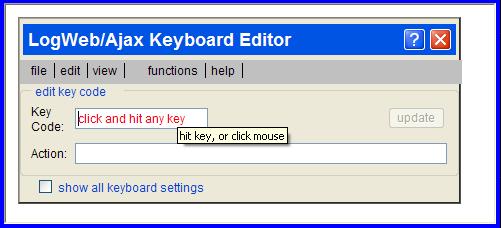
Basic operation:
- You can move the dialog as usual to an appropriate position in the emulation window
(click the blue title bar with the mouse and then drag it)
or modify the size
(click the blue border with the mouse and then drag it).
- In the keyboard editor, you use the fixed menuline (menu bar) to access important functions such as
- In the edit key code area, you can select a
key code or a mouse code (Key Code field)
and then remove or change
the code or insert new code.
- In the show all keyboard settings area, you can view the current keyboard settings in a list.
Note:
- Before editing an entry, you must select the corresponding keyboard code or mouse code.
- You can undo the changes one at a time by selecting [edit]/[undo] in the keyboard editor.
Selecting mouse code
Before editing an entry, you must select the corresponding code in the Key Code field:
- Click the Key Code field.
- Perform the required mouse action, such as
right-click + SHIFT.
- The field displays your action in a short form,
in this example: S_ONCLICKRIGHT
- The current action for this code is displayed in the Action field.
- Click the Action field.
If you press the TAB key instead, you select the code of the TAB key instead of the mouse code. Click the Key Code field again, as described above.
- You can now remove or change the code or insert new code.
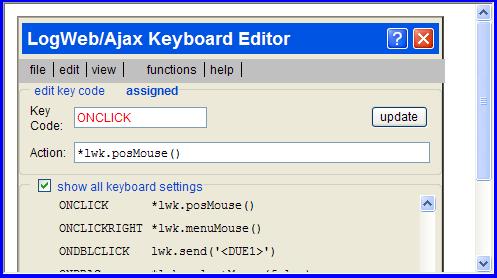
You can edit the following mouse codes:
- onclick: Click the left mouse button
(click and release the left mouse button without moving the mouse).
- onclickright: Click the right mouse button (context click)
(click and release the right mouse button without moving the mouse).
- ondblclick: Double-click the left mouse button.
- ondrag: Click and drag with the left mouse button
(click the left mouse button, move the mouse and release the left mouse button).
- ondragright: Click and drag with the right mouse button
(click the right mouse button, move the mouse and release the right mouse button).
Each mouse code can further be modified by pressing modification keys at the same time:
- S_: First press SHIFT and then press the mouse button.
- C_: First press CTRL and then press the mouse button.
- A_: First press ALT and then press the mouse button.
- If you press these special keys simultaneously before pressing the mouse button, the modifiers are combined accordingly.
Example: If you first press SHIFT and ALT and then press the left mouse button, the mouse code SA_onclick is created.
Selecting keyboard code
Before editing a keyboard entry, you must select the corresponding code in the Key Code field:
- First, place the cursor in the Key Code field.
The mouse code displayed here is unimportant.
- Then, in the Key Code field, press the key or key combination that you want to edit, for example, F9 + ALT.
- The field displays the short form of the key code,
in this example: A_F 9.
- The current action for this code is displayed in the Action field.
- Click the Action field.
If you press the TAB key instead, you select the code of the TAB key instead of the key code. Now, click the Key Code field again and repeat the key entries as described above.
- You can now remove
or change the selected code or insert new code.
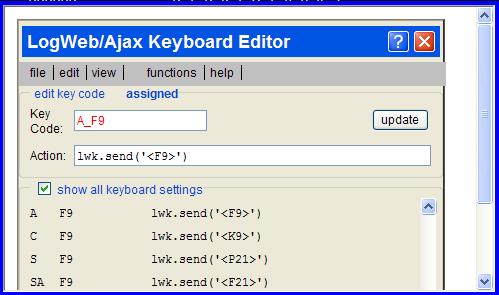
Except for the keys found on a conventional type writer, almost every key can be set up individually. The individual key code is displayed in the Key Code field.
Examples:
- F1, F12,.. : Function keys in the top row of the keyboard
- UP, INSERT,.. : Keys of the cursor block
- TAB, ESCAPE, RETURN,.. : Special keys
- NUM0, NUMMINUS,.. : Keys of the separate number block
Note:
- The function of these keys depends on the setting of the NUM LOCK key.
- The ENTER key of the number block produces the same code as the regular RETURN key; therefore, these keys can only have the same settings.
- $123,.. : No individual name is defined for these keys. However, they can be set up individually as long as they are not "inactive keys" (accent key...).
Each key code can also be modified by pressing modification keys at the same time:
- S_: First press SHIFT, then press the key to be modified.
- C_: First press CTRL, then press the key to be modified.
- A_: First press ALT, then press the key to be modified.
- If you press these special keys simultaneously before clicking the mouse button, the modifiers are combined accordingly.
Example: If you press SHIFT and ALT first and then the left arrow key, the key code SA_LEFT is created.
Displaying current settings in a list
If you select show all keyboard settings, all current key and mouse settings are displayed in a list:
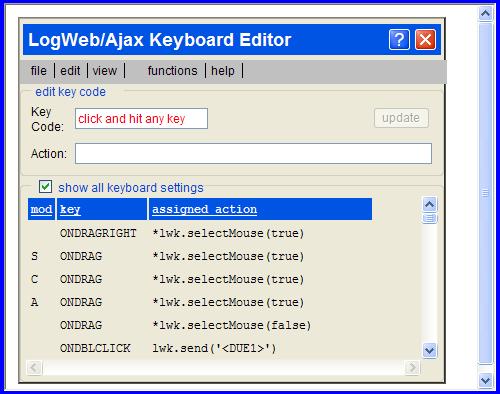
- The first column mod contains the modifiers for the code.
- The second column contains the primary key and mouse code.
- The third column displays the assigned action.
This is usually a JavaScript function call, such as lwk.send ('<ENTER>').
If an asterisk precedes the action, the macro editor does not record the action (example: *lwk.selectMouse(): "selecting text" is not recorded).
- If you click the column heading, the list is sorted in ascending or descending order by codes or assigned actions.
Deleting entries
You can delete the assigned function for each key code or mouse code:
- First, select the corresponding
key code or mouse code.
- Delete the assigned action in the Action field.
- Then click update.
Note:
- You can undo the changes and deletions one at a time by selecting [edit]/[undo] in the keyboard editor.
Changing or adding entries
You can change or reassign the function for each key code or mouse code:
- First, you must select the corresponding
key code or mouse code.
- The currently assigned function is displayed in the Action field.
If this field is empty, no function is as yet assigned to this code.
- Then, on the editor menu, click functions.
The list of available functions opens.
- Select a new action from the functions list.
- Your selection is displayed in the Action field in the menu editor, and the list of functions is created.
- Then click update.
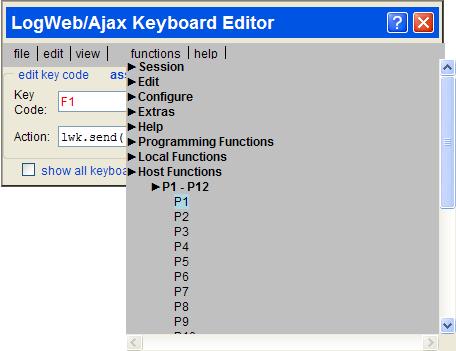
Note:
Undoing changes
You can undo all the changes that you make:
- In the editor menu, select [edit]/[undo].
- The last change is undone.
- The list with the current settings is reset accordingly.
Saving keyboard files
All changes that you make using the keyboard editor
are instantly displayed in the emulation window;
however, you must save them explicitly if you want them to be available
after restarting the emulation.
- On the menu bar of the editor, select [file]/[save file as].
- The "save file" dialog is displayed.
- Enter a name for the keyboard file.
- Click "save".
- If you click "cancel" instead, the keyboard file is not saved.
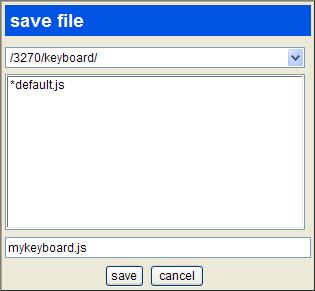
Note:
- You cannot undo "save file as" by using [edit]/[undo].
However, you can delete the file on the server.
- If you are not authorized to save files,
this could be due to your system settings.
In this case, contact your system administrator.
- You can only save files in your user directory on the server.
Only the system administrator can give other users access to your files.
Loading keyboard files
If required, you can load another keyboard file in the editor
and then edit this file:
- On the menu bar of the editor, select [file]/[open file].
- The "open file" dialog is displayed.
- Select the required keyboard file.
- Click "open".
The file is loaded and the settings are displayed in the list.
- If you click "cancel" instead, the keyboard file is not loaded.
Note:
- If you load a keyboard file, the current keyboard file is overwritten.
- You can restore these settings
by clicking undo.
- You can only load files from your user directory or from your group directory.
Only the system administrator can give you access to files belonging to other users or groups.
Deleting keyboard files
If a keyboard file is no longer needed, you can delete the file on the server:
- On the menu bar of the editor, select [file]/[remove file].
- The "remove file" dialog is displayed.
- Select the required keyboard file.
- Click "remove".
- If you click "cancel" instead, the keyboard file is not deleted.
Note:
- If you are not authorized to delete files,
this could be due to your system settings.
In this case, contact your system administrator.
- You can only delete files on the server that are in your user directory.
Only the system administrator can delete files belonging to other users or group.
- You cannot undo "remove file" by using [edit]/[undo].
Displaying and directly changing source code.
You will usually need only the keyboard editor options to edit the keyboard and mouse settings. If required, however, you can view and directly change the generated source code:
- On the menu bar of the editor, select [edit]/[JavaScript source].
- In the keyboard editor, a text area appears with the JavaScript source code.
- You can change the source code.
- Click "update" to apply the changes.
- If you clear the "edit current source" check box,
your changes are lost.
- In both cases, the source code is hidden again.
Note:
- The description of the keyboard files gives you an introduction to generated JavaScript source codes.
- To make changes to the source code of the JavaScript keyboard, the corresponding programming knowledge
and knowledge of LogWeb/Ajax programming interfaces is required
( API ).
- You can undo changes to the source code
by selecting [edit]/[undo] in the keyboard editor.
© Logics Software 2006 - 2009






